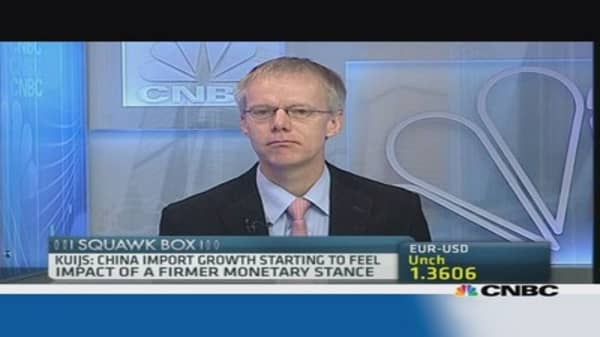At the beginning of the year, China's shadow banking system grew rapidly. With credit creation notably outstripping gross domestic product (GDP), the government attempted to reduce the risk that the system would foster a new generation of non-performing loans.
Yet it overbalanced. The ensuing clampdown led to a spike in interbank interest rates and very nearly caused a credit crunch. Credit creation dropped sharply, particularly in the non-bank sector, where new loans dropped to CNY815 billion in May, June and July from CNY2,900 billion in the previous three months. The negative consequences for growth were clear. Purchasing managers' indices were stagnant, and the Shanghai composite index dropped as much as 15 percent through June.
To correct this, China's government once again veered in the other direction, with a so-called mini-stimulus and a pick-up in credit growth. Now most economists expect yet another veer in the other direction.
(Read more: Don't bet against China just yet: HSBC)
Following these short-term wobbles, investors should watch out for volatility surrounding the implementation of longer-term Plenary policies. One example of this is liberalizing interest rates. An underpricing of capital by state-owned banks and favorable treatment of state-owned enterprises have allowed inefficient and unprofitable businesses to stay afloat. Without letting rates move more freely, China's over-capacity problems are likely to persist.
But although such measures would help China regain its balance to a degree, none of them will create true equilibrium unless China scraps its growth target. When trying to keep their balance, professional tightrope walkers will calmly correct, pausing and sitting if necessary, before treading carefully forward. In contrast, amateurs swing violently from side to side before falling off the rope. If scrapping the growth target proves a step too far for the government, the best that can be hoped for is that China rethinks its strategy, slows down, and opts for a more measured march forward.
— By Alexander Friedman, Global Chief Investment Officer at UBS Wealth Management, and Kiran Ganesh, Cross-Asset Strategist at UBS Wealth Management
Alex oversees the investment policy and strategy for approximately $1.7 trillion in assets and heads up a team of 900 analysts globally. Previously, Alex was Chief Financial Officer of the Bill & Melinda Gates Foundation and a member of the foundation's management committee.He has been regularly interviewed by international media such as Financial Times, Bloomberg, CNBC, The Economist etc and contributes byline articles to the Financial Times.




